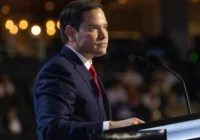It was summer almost half a century ago when I got into that Volkswagen van and began my trip across America with Peter, a photographer friend. I was officially doing so as a reporter for a small San Francisco news service, having been sent out to tap the mood of the nation in a politically fraught moment. The Vietnam War, with all its domestic protests and disturbances, was just ending. North Vietnamese troops would soon enough enter Saigon, the South Vietnamese capital; the president of the United States, Richard Nixon, was then trapped in an escalating scandal called “Watergate.”
And here was the odd thing. I felt trapped, too. In some way, I felt lost. As I put it then — and this should have a familiar ring to it, even if, in 1973, I was only referring to the TV version of the news — “That screen haunted my life. Somehow I wanted to shatter it and discover new, more human reference points, a true center of gravity.” I had the urge to break out of that world of mine and do the all-American thing, the Jack Kerouac thing: go “on the road.”
Held Together With String, Can America Hold?
So, Peter and I set out on that famed American road, traveling from campgrounds to fast-food restaurants, carnival midways to Old Faithful, only to find ourselves trapped in what I called “the increasing corporate control not just of people on the job, but on their vacations, in their leisure hours.” I found myself interviewing, and him photographing, what I came to think of as a “population of disoriented nomads” — mostly lower-middle-class and working-class Americans, confused and angry, “pushed aside,” as I wrote then, by “forces they feel are beyond their control.” We were, it turned out, on someone else’s road entirely.
In Milwaukee, we would be joined by Nancy, who later became my wife, and then would spend weeks following those all-too-unromantic highways (without a Jack Kerouac in sight), interviewing anyone who would talk to us. In the end, that attempt of a 29-year-old to break free from his own life, to figure out “where (or whether) I fit into American society” became my first book, “Beyond Our Control: America in the Mid Seventies.” In retrospect, that book about our strange journey into a country being reorganized for eternal consumption and the wellbeing of giant corporations became my own — as I would then call it — “dream-document excavated from our recent past.”
And yes, even so long ago, it was already a troubled moment in a troubled land. I must admit, though, that I hadn’t looked at “Beyond Our Control” in years, not until a friend recently found a copy, read it and emailed, quoting my own ancient text back to me to point out how eerily relevant it still was, how — in a sense — Trumpian parts of that 1973 America already were.
He highlighted, in particular, an interview near the end of that book with “Frank Nelson” — I changed all the names, so who knows now what his real one was — about which more in a moment. That missive startled me. I had forgotten all those Frank Nelsons and perhaps as well the Tom Engelhardt who interviewed them so long ago.
So, curious about that long-lost self of mine and the world I then inhabited, I picked up that old book and reread it in order to meet the young Tom Engelhardt on the road in another American universe. And how strange that journey back into my own — and our — past proved to be.
The Right Wind Sweeping In Off the Plain
So, if you have the patience for a little time travel, return with me to July 1973 and let me tell you about Frank Nelson, whom I met at a trailhead in Yellowstone National Park with his wife and three children. He was “a responsible, likeable family man” with — regardless of how hard I pressed him — “no vision of a better future.” A plumber and union shop steward from Cleveland, as well as the chairman of the union bargaining committee in his factory, he proudly told me, “I have really dedicated myself to the labor movement all my life and I believe in it.”
Yet he was already talking back then about the growing “conservative approach” of the trade union movement and the possibility that it would be destroyed, he believed, by “the race issue.” He was clearly both anti-Semitic and racist. (“Being white, I would prefer the continued supremacy of the white race instead of this homogenization that’s coming.”) And while discussing what he felt was a growing American crisis with me, he also told me that “your liberals believe in one world government … and your conservatives” — which he clearly believed himself to be — “believe in America first, American domination.” And remember, this was July 1973, not July 2019. It was Nixon’s America, not Trump’s.
Frank and his wife Helen were open, chatty and so pleased with the interview experience that she gave me their address and asked me to send them a copy of anything I wrote. In other words, he said nothing he felt was out of the range of propriety. My reaction, on leaving him, was: “For me, this interview seemed like the crescendo towards which the bits and pieces of our trip have been building.”
As I had discovered in those weeks of interviewing, Nelson, like so many others on that vacation loop, was filled to the brim with half-spoken and unspoken fears about a future in which, as I put it then, “the [corporate] pushers will survive, maybe even profit. It’s these people we’ve talked with, the vast mass of middle people who have barely eked out a toehold in the system, who will be cut off at the knees. And, being hooked [on that system], they don’t know what to do.”
Then, thinking about Nelson (and others like him we had met), I added:
“The next step for Frank Nelson, however, may be out of this passivity and into the streets … The motivation, the frustration, the anger is there. Even a new ideology, the ideology of race and nationalism is emerging. All that’s missing is the right wind sweeping in off the plain, a combination of forces at the top of the society willing to mobilize Frank Nelson.
… Sinking people don’t usually have a trenchant analysis of reality. All they require is the promise that their hard-won sense of status will not go down the drain; and an explanation, any explanation, on which to hang their hopes. American society leaves people so confused and reality so disjointed that almost any formula which pretends to put the pieces together and appeals to what people think of as their self-interest may prove acceptable.”
In those pages, I had already brought up Weimar-era Germany — the moment, that is, before Adolf Hitler rose to power — and then I added:
“In Germany in the thirties, the formula that worked was anti-Semitism, anti-communism, and a rabid nationalism combined with full employment and a return to domestic stability. If Frank Nelson’s any criterion, the formula may not be that much different here … Nationalism could well be the banner under which the struggle and the inevitable sacrifices will come, and race the bogeyman just as Jews were in Germany. The identifiable (Black) poor are the symbol for Frank Nelson of what he has to lose, what could be ripped out of his hands. And he’ll defend himself against that even if he has to ally himself with ‘the Jews and rich Gentiles’ to do it.
Frank Nelson and millions of other Americans are set up for the picking, if a group at the top sees profit in the crop.”
Welcome to a More Extreme World
In the age of Donald Trump, the Proud Boys, and the Wolverine Watchmen, much of this should feel strangely familiar. If, however, my reporting was in any way prophetic, I have to admit that I didn’t realize it all these years — not until my friend wrote me. Still, it should be obvious, in retrospect, that, bizarre as the present moment may seem, it didn’t come out of the blue, not faintly. How could it have?
For that matter, Trump didn’t exactly arrive out of the blue either. As a start, just a couple of months after I got back to San Francisco from that cross-country jaunt of ours, he made his first appearance on the front page of The New York Times. He was 27, two years younger than me, and already the president of the Trump Management Corporation. The headline, shades of the future Donald and the white nationalism that’s accompanied him, was: “Major Landlord Accused of Antiblack Bias in City.”
The Justice Department was then charging Trump’s father Fred and him with refusing “to rent or negotiate rentals ‘because of race and color'” in the buildings they then owned and managed. And his first words quoted in that paper about those charges were, appropriately enough: “They are absolutely ridiculous … We never have discriminated and we never would.” Of course not! And what hasn’t been increasingly, ridiculously Trumpian about our all-American world ever since?
When you think about it, with that moment in 1973 in mind, Trump himself might be reimagined as some extreme combination of Richard Nixon (a man with his own revealing tapes just like The Donald) and George Wallace. The racist governor of Alabama and a third party candidate the year Nixon slipped by Democrat Hubert Humphrey to first win the White House, Wallace was a man best known for the formulation “segregation now, segregation tomorrow, segregation forever.”
Nixon took the presidency in 1968 and again in 1972 with his own form of racism, the “southern strategy,” first pioneered by Republican presidential candidate Barry Goldwater in 1964 (and then called, far more redolently, “Operation Dixie”). In a racially coded and distinctly nationalist fashion, Nixon brought southern whites in the formerly Democratic bastions of the South definitively into the Republican fold.
By 1980, Ronald Reagan wouldn’t think twice about launching his own presidential election campaign with a “states’ rights” speech (then still a code phrase for segregation) near Philadelphia, Mississippi, just miles from the earthen dam where three murdered civil rights workers had been found buried in 1964. And in the intervening years, the Republican Party, too, has gone south (so to speak) big time and into a form of illiberality that was, even in the Nixon era, striking enough. By 2016, of course, that southern strategy had become something more like a national strategy in the (pussy-grabbing) hands of Donald Trump.
Meanwhile, the corporatization — I might, then, have thought of it as the fast-foodization — of the country that Peter, Nancy and I were traveling across was already well underway. At the same time, a new kind of all-American inequality was, in those years, just beginning to make itself felt. Today, with the first billionaire in the White House and other billionaires, even in the midst of a pandemic, continuing to make an absolute mint while so many Americans suffer, the inequality that left Frank Nelson and his peers so desperately uneasy has never stopped rising to truly staggering levels.
Believe me, even if Trump has to leave the Oval Office on January 20, 2021, we’ll still be in his America. And 47 years after my long, strange trip, I think I can guarantee you one thing: If it weren’t for the pandemic that has this country in its grasp and has swept so many of us off any path whatsoever, some young reporter, stir crazy and unhappy, would still be able to head out onto a 21st-century “road” and find updated versions of Frank Nelson galore (a surprising number of whom might be well-armed and angry).
Welcome to America! There’s no question that, so long after Peter, Nancy and I traveled that not-so-open road, our lives and this country are way beyond our control.
Writing about the people I had interviewed then (about whom, with the single inspirational exception of a museum director I met in Twin Falls, Idaho, I knew nothing more), I said: “I don’t doubt that they, like me, are still heading reluctantly toward a future that will make the summer of 1973 seem truly unreal and leave us all wondering: Could life ever have really been that way?”
In COVID-19 America, with the West Coast still burning, Colorado in historic flames, a record 11 storms hitting the Gulf Coast and elsewhere this hurricane season, and heat of every sort rising everywhere, don’t for a second believe that the phrase “beyond our control” couldn’t gain new meaning in the decades to come.
Welcome to a more extreme version of the world Frank Nelson and I already inhabited in 1973.
*[This article was originally published by TomDispatch.]
The views expressed in this article are the author’s own and do not necessarily reflect Fair Observer’s editorial policy.
Support Fair Observer
We rely on your support for our independence, diversity and quality.
For more than 10 years, Fair Observer has been free, fair and independent. No billionaire owns us, no advertisers control us. We are a reader-supported nonprofit. Unlike many other publications, we keep our content free for readers regardless of where they live or whether they can afford to pay. We have no paywalls and no ads.
In the post-truth era of fake news, echo chambers and filter bubbles, we publish a plurality of perspectives from around the world. Anyone can publish with us, but everyone goes through a rigorous editorial process. So, you get fact-checked, well-reasoned content instead of noise.
We publish 2,500+ voices from 90+ countries. We also conduct education and training programs
on subjects ranging from digital media and journalism to writing and critical thinking. This
doesn’t come cheap. Servers, editors, trainers and web developers cost
money.
Please consider supporting us on a regular basis as a recurring donor or a
sustaining member.
Will you support FO’s journalism?
We rely on your support for our independence, diversity and quality.






